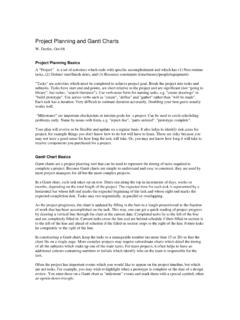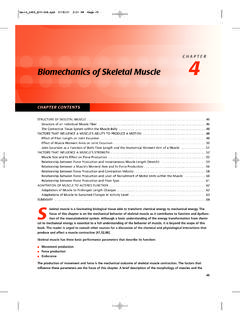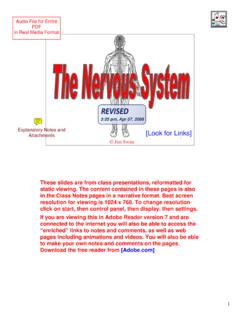Transcription of The Neuromuscular Junction - University of …
1 Neuromuscular Junction Lecture Notes These notes supplement the lectures and cover background material that will help place the experiments in context. University of Minnesota Version: July, 2011 NMJ Lecture Notes 1 Table of Contents 1 Muscle Contraction: cardiac, smooth and skeletal_____ 3 2 The Neuromuscular Junction _____ 13 3 Membrane Resting Potential _____ 21 4 NMJ References _____ 29 5 Readings _____ 31 NMJ Lecture Notes 3 1 Muscle Contraction: cardiac, smooth and skeletal 1. Types On the basis of structure, contractile properties and control mechanisms, three types of muscle can be identified: 1) skeletal muscle, 2) smooth muscle and 3) cardiac muscle. Although there are significant differences between these muscle types, the force-generating mechanisms are similar.
2 Skeletal Muscle: most skeletal muscle is attached to bone and its contraction is responsible for supporting and moving the skeleton. The contraction of these muscles is initiated by action potential propagating down motoneurons to the muscle and can be under voluntary control. Smooth Muscle: sheets of smooth muscle surround various hollow organs and tubes ( , stomach, intestines, urinary bladder, uterus, blood vessels and airways). Contraction of these cells may propel the luminal contents through the organ or regulate internal flows by changing tube diameters. Single and groups of smooth muscle cells are also found distributed throughout organs and perform various other functions: , iris of the eye and attachment of hair.
3 Smooth muscle contraction can be spontaneous or controlled by: the autonomic nervous system, hormones and other chemical signals. Cardiac Muscle: The muscle of the heart surrounds four pumping NMJ Lecture Notes 4 chambers. Contraction of cardiac muscle provides the impetus for the movement of blood through the pulmonary and systemic circulatory systems. Spontaneous cycling of an intrinsic pacemaker triggers each heartbeat (or contraction). However the autonomic nervous system and circulating hormones modulate the frequency of this activation. 2. Structure and Function of Skeletal Muscle If one sections through a skeletal muscle, one can observed that it is organized into bundles of fibers call fascicles. The individual muscle fibers, multinucleated cells, contain long slender structures called myofibrils.
4 These are made of myofilaments, which are organized into sarcomeres, the functional unit of contractions. Both skeletal and cardiac muscle have a striated appearance under a light microscope, due to the organization of the myofilaments. Each myofibril is composed of thick and thin filaments arranged in a repeating pattern along their length. thick filaments are composed primarily of the protein myosin and the thin filaments are made up the three proteins, troponin, tropomyosin and actin. It is the cyclic binding between myosin heads of the thick filament and actin of the thin filaments, crossbridge formation, that allows of force production or muscle shortening. It should be noted, that there exist other proteins within sarcomere which have recently been shown to have a role in contractile function, , the elastic protein titan (also known as connectin).
5 3. The Motor Unit A single motor unit consists of one motor neuron and all of the muscle fibers it innervates. The cell bodies of motor neurons are located within the brainstem or spinal cord. The axons of these neurons are myelinated and large in diameter, and thus are able to propagate action potentials at high velocities. Once an alpha motor neuron is activated to produce an action potential, all of the fibers innervated by this neuron are activated and contract simultaneously. Each motor unit is made up of one type of muscle fibers: , slow twitch, fast-twitch fatigable or fast-twitch fatigue resistant. NMJ Lecture Notes 5 4. Excitation-Contraction Coupling This refers to the sequence of events by which an action potential in the plasma membrane of the muscle fiber leads to force production via an increase in intracellular calcium and crossbridge formation and turn-over.
6 Excitation begins at the Neuromuscular Junction and then the action potential spreads over the surface membrane and inward into the fiber via the transverse tubule system (invaginations of the sarcolemma). This inward excitation activates calcium release from the sarcoplasmic reticulum. The calcium then binds to the thin filament and crossbridge formation occurs. NMJ Lecture Notes 6 4. The Neuromuscular Junction Each branch of a motoneuron forms a single Junction with a muscle fiber . The myelin sheath surrounding the motor axon ends near the surface of the muscle fiber and the axon divides into a number of short processes that lie embedded in grooves on the muscle-fiber surface. This region of the sarcolemma (muscle membrane) is known as the motor end plate.
7 Acetylcholine is the neurotransmitter in these synapses. End-plate potentials (EPPs) can be recorded at the motor end plate when the presynaptic membrane is activated to release vesicles containing the acetylcholine. Steps in Neuromuscular transmission: 1) nerve action potential. 2) calcium entry into the presynaptic terminus. 3) release of Ach quanta. 4) diffusion of Ach across cleft. 5) combination of Ach with post-synaptic receptors and Ach breakdown via esterase. 6) opening of Na+/K+ channels (cation channels). 7) postsynaptic membrane depolarization (EPP). 8) muscle action potential. NMJ Lecture Notes 7 5. Molecular Mechanism of Contraction Excitation of the sarcolemma and transverse-tubule system causes activation of a population of voltage-gate calcium channels located in the tubules themselves.
8 The channels also known as the dihydropyridine receptors signals, by yet some unknown mechanism, the adjacent calcium-release channels on the sarcoplasmic reticulum (ryanodine receptors) to allow calcium to be released from this storage site. Hence, the intracellular [Ca2+] increases ( , sarcoplasmic concentration) which then diffuses and binds to troponin on the thin filaments which allows for crossbridge formation between actin and myosin by removing the steric interaction imposed by tropomyosin. Shown to the right is the association between changes in intracellular [Ca2+] and force. The change in Ca concentration is detected using a fluorescent calcium indicator dye so that changes in relative light is related to changes in calcium concentration.
9 Note that a rise in calcium precedes force production and intracellular [Ca2+] decrease well before force. NMJ Lecture Notes 8 Functional Overview A Neuromuscular Junction sends excitatory signals from the CNS via the neurotransmitter, acetylcholine which binds to nicotinic receptors on the post-synaptic membrane. The binding causes a local change in the voltage of the sarcolemma affecting neighboring channels (Na+ to enter and eventually K+ to flow out). This ion movement produces the action potential which propagates along the sarcolemma and inward via the transverse tubule system. This rapid voltage change initiates the gating of dihydropyridine receptors which in turn causes the release of calcium from the sarcoplasmic reticulum via the ryanodine receptors.
10 The released calcium binds to troponin inducing a conformation change in tropomyosin, also a component of the contractile apparatus, which in turn allows crossbridge formation between actin and myosin (an energy dependent process). The crossbridge formation leads to muscle fiber shortening and the generation of force. Crossbridge cycling will proceed until calcium dissociates from troponin and the inhibitory influence of tropomyosin is reestablished. The dissociation occurs because calcium release stops and its active uptake (requiring ATP) into the sarcoplasmic reticulum causes a reduction. 7. Metabolic pathways producing the ATP utilized during muscle contraction There are three primary ways a muscle fiber can form ATP during contractile activity: 1) phosphorylation of ADP by creatine phosphate; 2) oxidative phosphorylation of ADP in NMJ Lecture Notes 9 mitochondria (need myoglobin for oxygen transfer); or 3) substrate phosphorylation of ADP, primarily by the glycolytic pathway in the cytosol (forming lactic acid).











